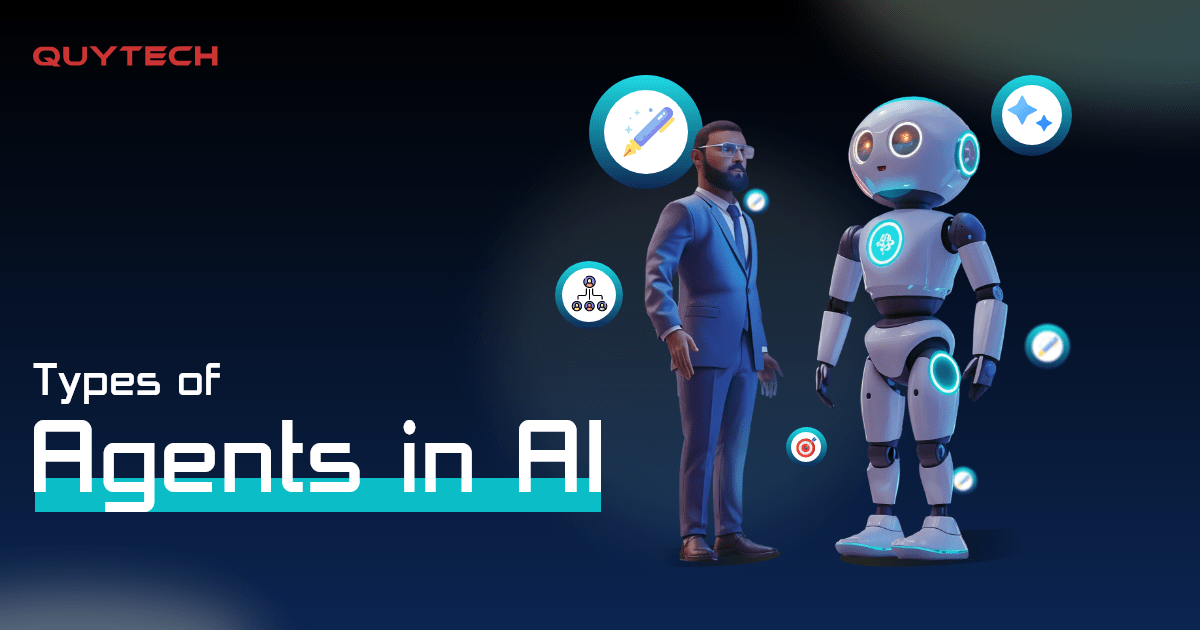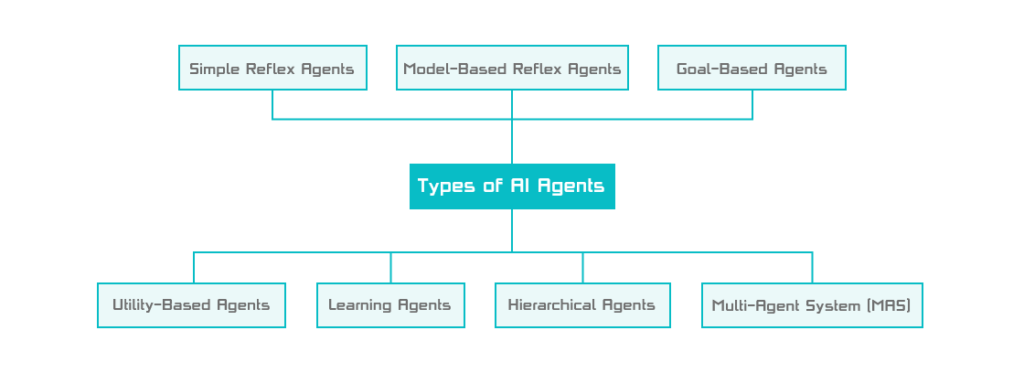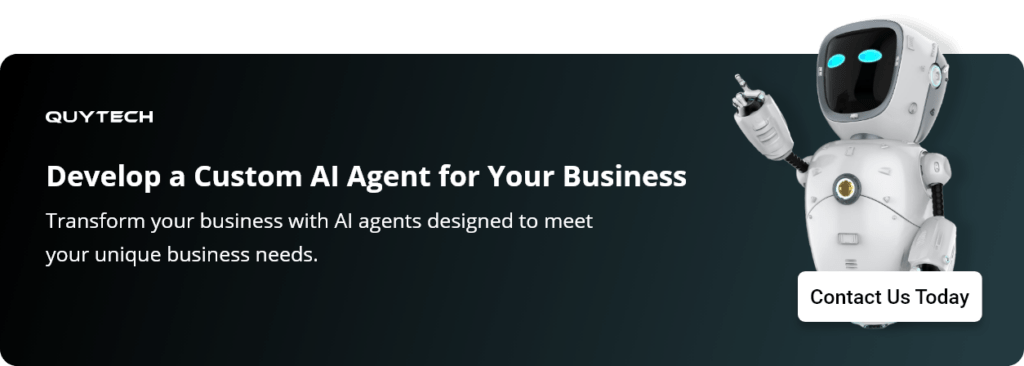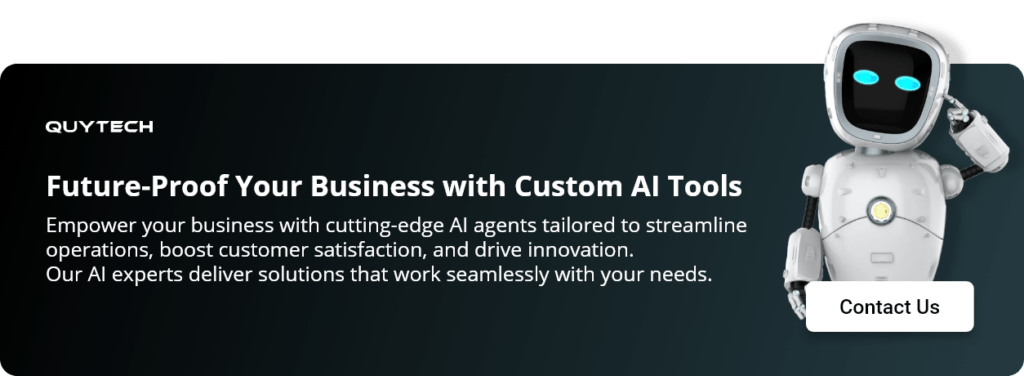Businesses use different types of AI agents to perform operations and tasks. AI agents are programs or software that interact with their environment and perform different tasks, without requiring continuous human interventions.
You can understand the popularity of AI agents in businesses by looking at the growth of their market size. The AI agents market is $5.1 billion in 2024 and is estimated to be approximately $47.1 billion by 2030, expanding at a CAGR of 44.8% during the forecast period.
AI agents solve major problems for various businesses. Businesses implement AI agents and the operations will be automated, freeing up the human workforce.
There are different types of AI agents designed to perform different tasks. In this blog, we will discuss these AI agent types, their features, and use cases. So, let’s start.
What are AI Agents?
Before diving into types, let’s understand AI agents, their components, and how they work.
AI agents are software that are designed by AI developers to perform certain assigned tasks. These agents are different from conventional chatbots as they are developed using sophisticated algorithms that empower them to interact with the environment, collect data, analyze, and choose the best way to complete the assigned tasks, all with minimal or no human intervention.
How AI Agents Work?
AI agents are designed to perform various types of tasks, including simple to complex ones. Here is how AI agents function:
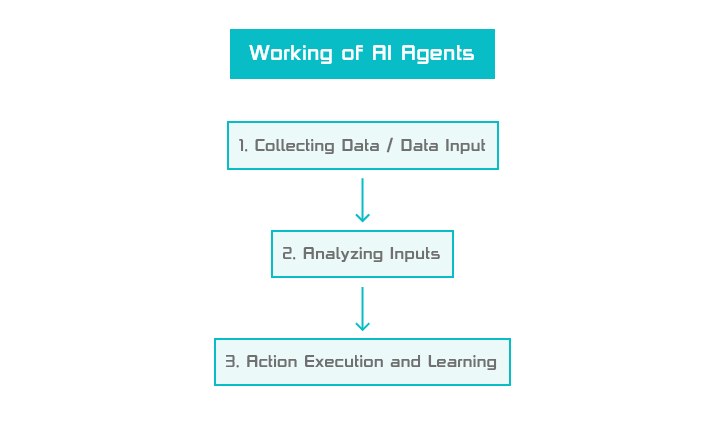
1. Collecting Data/ Data Input
AI agents start working by collecting data from the environment. The data may be in the form of text commands, data collected from sensors, or data streams. After collecting the data, the perception modules in the AI agents convert raw data into a processed format that can be understood by the AI agents.
2. Analyzing Inputs
At this stage, AI agents analyze the information they collect from the environment. They leverage advanced AI algorithms to identify patterns in the data and make decisions that work best to achieve the assigned goals. Moreover, these sophisticated machine learning algorithms allow AI agents to learn from previous interactions and update their actions and responses over time.
3. Action Execution and Learning
After making the decision, the AI agents execute actions to perform a certain task. These agents consist of action modules that ensure that the chosen action is executed properly. Moreover, AI agents learn from experiences and feedback, update their decision-making, and develop optimal policies using reinforcement learning techniques.
Types of AI Agents: Understanding Their Architecture and Use Cases
AI agents have been categorized into seven types depending on designs and functionalities. The following are the various types of artificial intelligence agents.
01- Simple Reflex Agents
Simple reflex agents are the simplest type of AI agents that respond to inputs based on predefined conditions. These agents do not respond beyond the event if it is not mentioned while programming them.
Hence, if these agents experience a situation for which they ain’t prepared, they cannot respond to it. Simple reflex agents are ideal for processing simple tasks in the business.
Characteristics of Simple Reflex Agents
- These work on predefined conditions.
- They do not retain the memory of past actions.
- They respond instantly to environmental stimuli.
- They require low computational resources.
- They cannot adapt to dynamic environments.
Use Cases of Simple Reflex AI Agents
Simple reflex AI agents are implemented in:
- Automated thermostats adjusting temperature.
- Traffic light control systems.
- Basic robotic movements like obstacle avoidance.
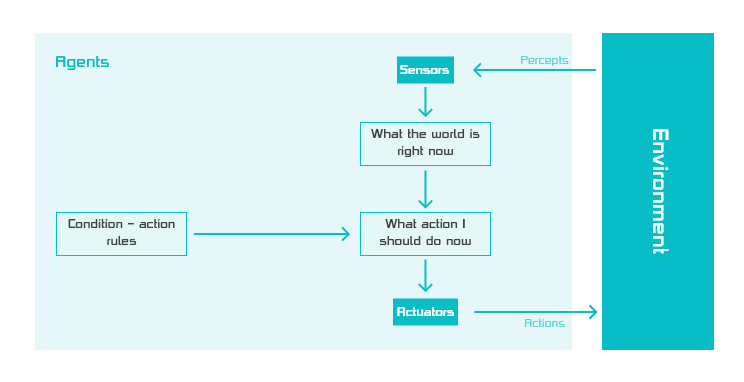
02- Model-Based Reflex Agents
Model-based reflex agents are the advanced form of simple reflex agents. They are equipped with internal models that represent the environment, enabling them to track how the world works and handle dynamic changes.
Model-based reflex agents use these previously mentioned models to evaluate the current state and predict the effects of their actions. Their ability to handle dynamic environmental changes makes them more versatile AI agents than simple reflex agents.
Characteristics of Model-Based Reflex Agents
- These AI agents have models that track how the world works.
- These can predict future states.
- They can adapt to environmental changes.
- They use memory to make better decisions.
- These are ideal for moderately dynamic environments
Use Cases of Model-Based Reflex Agents
Model-based reflex agents are implemented in:
- Autonomous drones exploring different spaces.
- Inventory management systems that predict stock requirements.
- Smart home devices.
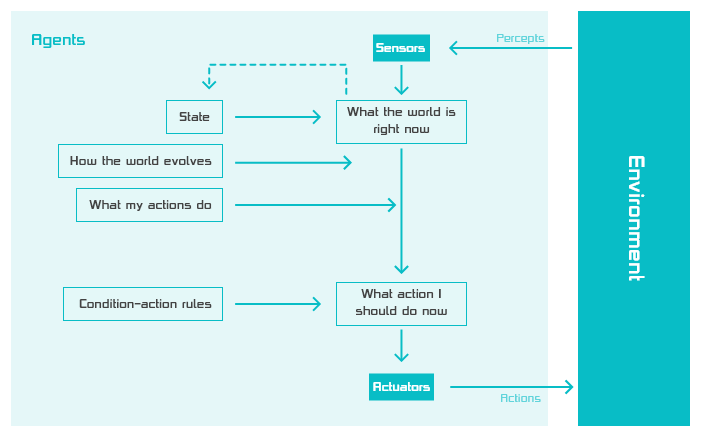
03- Goal-Based Agents
Goal-based agents are the type of AI agents that are directed to achieve certain goals by taking multiple actions in a sequence. Unlike simple and model-based reflex agents, which rely on immediate responses or predefined rules, goal-based agents evaluate different paths and use planning to reach their goals.
The goal-based agents leverage search and planning algorithms to prepare sequences of actions that guide them to achieve desired goals.
Characteristics of Goal-Based Agents
- These AI agents focus on achieving specific goals.
- They perform decision-making through planning.
- They can handle dynamic environments.
- They evaluate actions based on goal relevance.
- They are more resource-intensive than simple and model-based reflex agents
Use Cases of Goal-Based Agents
Goal-based agents are implemented in:
- GPS navigation systems finding optimal routes.
- Game-playing for achieving winning strategies.
- Robots assembling complex components.
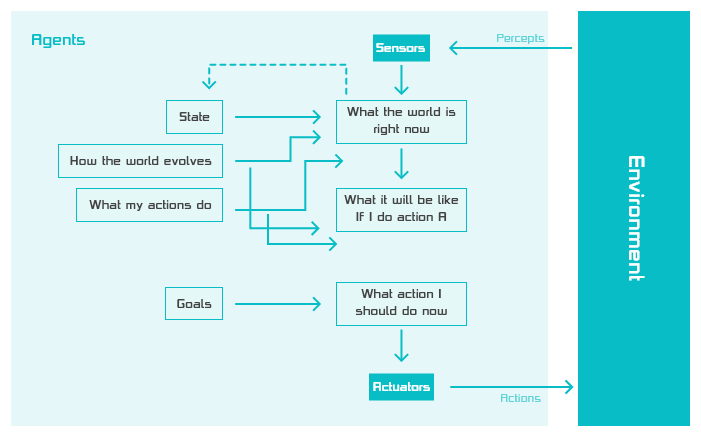
04- Utility-Based Agents
Utility-based agents are another type of AI agents that are used by businesses to perform tasks. These AI agents use complex reasoning algorithms to compare different outcomes of actions and choose the one that gives maximum benefits to the users.
Utility-based agents are ideal when there is a need to choose the best approach to solve a problem or overcome a challenge.
Characteristics of Utility-Based Agents
- They optimize decisions based on utility values.
- They handle trade-offs between conflicting objectives.
- They adapt to complex, dynamic environments.
- They consider both short- and long-term consequences.
- They use advanced computation for the best results.
Use Cases of Utility-Based Agents
Utility-based AI agents are implemented in:
- Financial portfolio management systems.
- E-commerce recommendation engines.
- Autonomous vehicles optimizing speed and fuel usage.
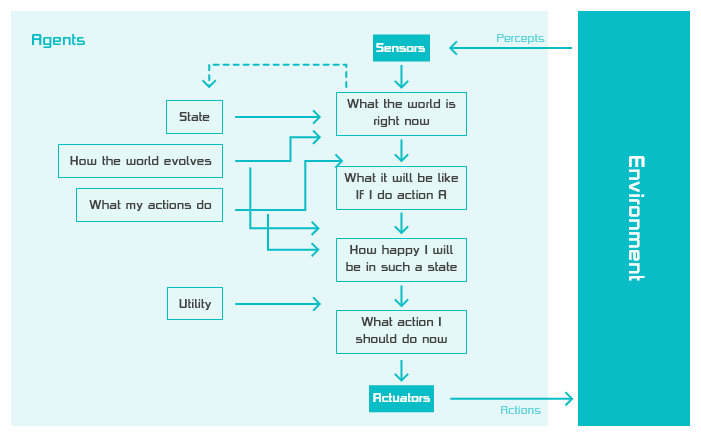
05- Learning Agents
Learning agents are the types of AI agents that learn from feedback and experiences and improve their functionalities. These agents use sensory input and feedback mechanisms to upgrade their learning and find new approaches to achieve a certain goal.
Learning agents are capable of making better decisions as they get exposed to more data, unlike simple reflex agents that function based on pre-defined conditions.
Characteristics of Learning Agents
- These agents learn from past interactions and feedback.
- They continuously improve decision-making.
- They use reinforcement learning or supervised methods.
- They adapt to changing environments effectively.
- They require significant data and computation.
Use Cases of Learning Agents
Learning agents are implemented in:
- Personalized virtual assistants like Siri or Alexa.
- Chatbots improving responses over time.
- Fraud detection systems in financial institutions.
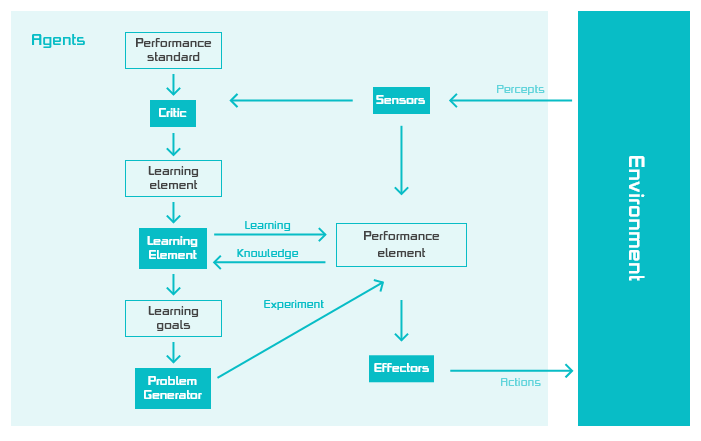
06- Hierarchical Agents
Hierarchical agents have a hierarchy system in which the main agent breaks down and divides the tasks among the sub-agents at the lower levels. All the agents in the hierarchy perform actions, often autonomously, and submit the report results to the supervising agent.
The supervising agent then compiles all the results and submits them to the main agent to show as an output to the users.
Characteristics of Hierarchical Agents
- These agents break down complex tasks into smaller subtasks
- They employ a structured system with main, supervising, and sub-agents.
- Sub-agents perform tasks independently within assigned scopes.
- Supervising agents aggregate outputs for cohesive task management.
- They easily adapt to handle increasingly complex or larger-scale tasks.
Use Cases of Hierarchical Agents
Hierarchical agents are implemented in:
- Multi-functional robots in assembly lines and automated factories.
- Traffic management systems for traffic optimization.
- Logistics and supply chain for managing distributed tasks
- Unmanned aerial vehicles (UAVs) with hierarchical command systems.
- Healthcare systems, such as multi-agent diagnostic or patient monitoring solutions.
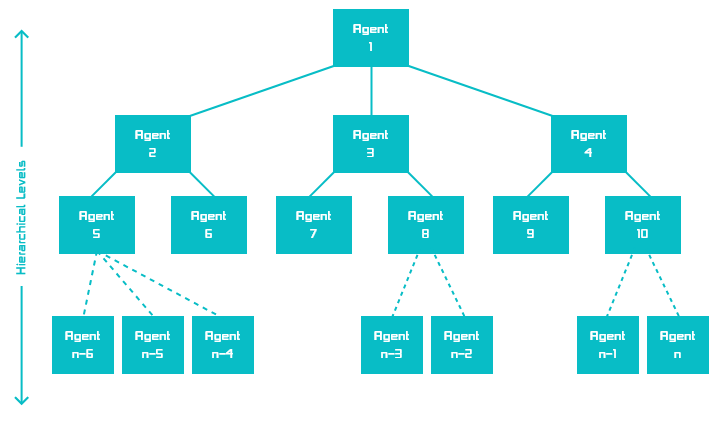
07- Multi-Agent Systems (MAS)
Multi-agent systems (MAS) are the types of AI agents that consist of multiple agents that work together to achieve a common goal. The individual agents in the MAS also coordinate their actions and often communicate with each other to achieve their goals efficiently.
The MAS has a group of autonomous and semi-autonomous AI agents, depending on the design of the MAS, that are capable of perceiving information from environments, making decisions, learning from their experiences, and more. All these agents join together and take action to achieve a common objective.
Characteristics of Multi-Agent Systems (MAS)
- All AI agents in MAS act independently and share responsibilities.
- AI agents in MAS communicate and exchange information with each other.
- Agents in MAS can make independent decisions based on local perceptions and goals.
- AI agents in MAS work together to achieve shared objectives.
- MAS agents adapt their behavior based on experiences or feedback.
Use Cases of Multi-Agent Systems (MAS)
MAS agents are implemented in:
- Autonomous vehicles coordinating with each other to optimize traffic flow and safety.
- Smart grids balancing supply and demand efficiently.
- Robots that coordinate to optimize production and task allocation.
- Supply chain management to streamline operations.
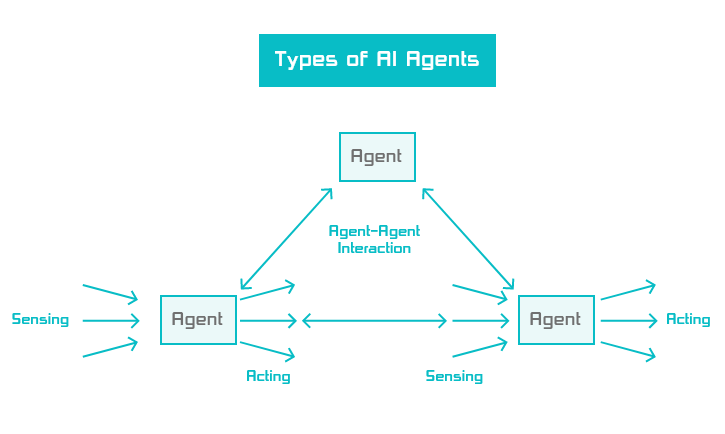
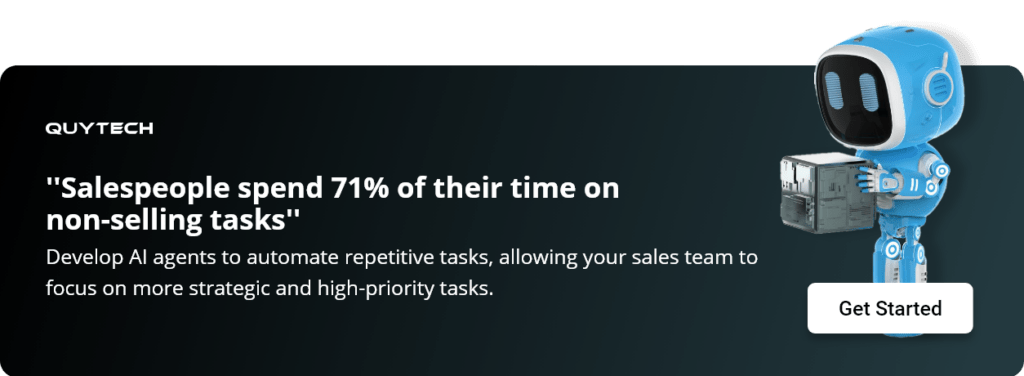
Benefits of Using AI Agents
The following are the benefits of leveraging artificial intelligence agents:
1. Task Automation
Businesses can use AI agents to automate tasks. AI agents are capable of collecting data, analyzing it, and performing actions to achieve certain goals. This enables businesses to implement AI agents to automate tasks like data entries, documentation, marketing, administrative work, bookkeeping, and more.
2. 24/7 Availability
Another benefit is that AI agents can work 24/7 and 365 days without any breaks. So, businesses can ensure that tasks are completed regardless of business hours and time zones. Moreover, AI agents can help businesses enhance their customer experiences by being available and solving customer problems around the clock.
3. Improved Productivity
In businesses, AI agents help teams improve productivity by automating repetitive tasks and sparing them free time to focus on more strategic work. This way, teams can perform crucial tasks more and contribute to the business’s growth.
4. Consistency and Accuracy
AI agents can perform operations consistently with high accuracy. We reduce the chances of errors to a significant extent and save time, resources, and capital for the businesses. Also, AI agents learn from experiences, meaning they can adapt their approaches over time, and maintain accuracy and consistency for a long time.
5. Scalability
AI agents can handle large amounts of data and can scale with time. As the task volume increases with time, AI agents can adapt themselves and keep performing the tasks without compromising the quality.
6. Reduced Costs
Lastly, AI agents reduce costs for businesses by automating various tasks that require manpower to perform. Businesses can save capital that would otherwise be required to hire experts and arrange salaries for them. Moreover, AI agents eliminate mistakes, hence reducing wastage and overall costs for achieving a certain goal.
Challenges That Arise While Using AI Agents
Businesses often face the following challenges while implementing and using AI agents.
1. Lack of Technical Expertise
Implementing AI agents in businesses requires deep knowledge and expertise in AI and machine learning development. Many businesses, especially startups, find it challenging to hire dedicated developers who have enough experience and expertise in developing, training, and implementing AI agents.
2. Limited Computing Resources
Another challenge of implementing AI agents in businesses is limited computing resources. It requires advanced systems and up-to-date computing infrastructure to deploy deep learning-powered AI agents. Hence, to integrate AI agents into the systems, businesses need to invest in costly infrastructure which is not practically possible for everyone.
3. Ethical Challenges
In some situations, AI agents can produce incorrect, unfair, and biased, results. Thus, it is challenging for businesses to rely fully on AI agents. Businesses need to practice safe practices such as human reviews, to verify the results delivered by AI agents.
The Future of AI Agents
AI agents are developed leveraging technologies such as AI, machine learning, deep learning, and more. In the coming years, as these technologies evolve, AI agents will inevitably become capable of handling more complex tasks in different domains.
Also, it is estimated that there will be a high demand for customized AI agents that will be developed to perform highly specific tasks for businesses. AI agents will play a significant role in helping businesses streamline operations and gain a competitive advantage.
Conclusion
AI agents are the tools that help businesses automate their tasks, without requiring much human intervention. Based on their functions and technologies, AI agents are categorized into seven types: Simple reflex, model-based, goal-based, utility-based, learning agents, hierarchical agents, and multi-agent systems (MAS).
In this blog, we have explained all the types of AI agents, along with their characteristics and use cases. AI agents offer benefits such as automating tasks, functioning 24/7, helping with improving productivity, offering consistency and accuracy, and reducing overall operational costs.
If you also want to develop AI agents tailored to your business needs, feel free to reach out to Quytech. We are the top AI development company that has helped clients worldwide with developing personalized AI agents, streamlining their operations, and achieving objectives.
If you also want to join the list, contact our experts today.
Frequently Asked Questions –
Here are some FAQs related to types of AI agents:
AI agents are tools powered by AI, machine learning, deep learning, and other technologies, designed to perform tasks and achieve predefined goals.
Based on functionalities and structure, there are seven types of AI agents – Simple reflex, model-based, goal-based, utility-based, learning agents, hierarchical agents, and multi-agent systems (MAS).
By developing AI agents, you can automate your business operations, engage with customers 24/7, ensure high accuracy and consistency, scalability, and reduce overall costs.
It takes around 3 to 6 months to develop an AI agent. However, the exact time is based on various factors, such as design, functionalities, technologies, development team, and more.
Quytech is a top AI development company that specializes in developing custom AI agents tailored to specific business needs. Reach out to our team today and get your AI agent developed.
